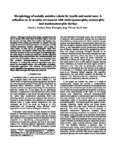Morphology of socially assistive robots for health and social care: A reflection on 24 months of research with anthropomorphic, zoomorphic and mechanomorphic devices
| dc.contributor.author | Bradwell, Hannah | |
| dc.contributor.author | Winnington, R | |
| dc.contributor.author | Thill, S | |
| dc.contributor.author | Jones, Ray | |
| dc.date.accessioned | 2022-02-08T17:10:24Z | |
| dc.date.available | 2022-02-08T17:10:24Z | |
| dc.date.issued | 2021-08-08 | |
| dc.identifier.isbn | 9781665404921 | |
| dc.identifier.issn | 1944-9445 | |
| dc.identifier.uri | http://hdl.handle.net/10026.1/18723 | |
| dc.description.abstract |
This paper reflects on four studies completed over the last 24 months, with social robots including Pepper, Paro, Joy for All cats and dogs, Miro, Pleo, Padbot and cheaper toys, including i) focus groups and interviews on suitable robot pet design, ii) surveys on ethical perceptions of robot pets, and iii) recorded interactions between stakeholders and a range of social robots. In total, up to 371 participants' views were included across the analysed studies. Data was reviewed and mined for relevance to the use and impact of morphology types for social robots in health and social care. Results suggested biomorphic design was preferable over mechanomorphic, and speech and life-simulation features (such as breathing) were well received. Anthropomorphism demonstrated some limitations in evoking fear and task-expectations that were absent for zoomorphic designs. The combination of familiar, zoomorphic appearance with animacy, life-simulation and speech capabilities thus appeared to be an area of research for future robots developed for health and social care. | |
| dc.format.extent | 376-383 | |
| dc.language.iso | en | |
| dc.publisher | IEEE | |
| dc.subject | Behavioral and Social Science | |
| dc.title | Morphology of socially assistive robots for health and social care: A reflection on 24 months of research with anthropomorphic, zoomorphic and mechanomorphic devices | |
| dc.type | conference | |
| dc.type | Conference Proceeding | |
| plymouth.author-url | https://www.webofscience.com/api/gateway?GWVersion=2&SrcApp=PARTNER_APP&SrcAuth=LinksAMR&KeyUT=WOS:000709817200054&DestLinkType=FullRecord&DestApp=ALL_WOS&UsrCustomerID=11bb513d99f797142bcfeffcc58ea008 | |
| plymouth.date-start | 2021-08-08 | |
| plymouth.date-finish | 2021-08-12 | |
| plymouth.volume | 00 | |
| plymouth.conference-name | 2021 30th IEEE International Conference on Robot & Human Interactive Communication (RO-MAN) | |
| plymouth.publication-status | Published | |
| plymouth.journal | 2021 30th IEEE International Conference on Robot & Human Interactive Communication (RO-MAN) | |
| dc.identifier.doi | 10.1109/ro-man50785.2021.9515446 | |
| plymouth.organisational-group | /Plymouth | |
| plymouth.organisational-group | /Plymouth/Faculty of Health | |
| plymouth.organisational-group | /Plymouth/Faculty of Health/School of Nursing and Midwifery | |
| plymouth.organisational-group | /Plymouth/REF 2021 Researchers by UoA | |
| plymouth.organisational-group | /Plymouth/REF 2021 Researchers by UoA/UoA03 Allied Health Professions, Dentistry, Nursing and Pharmacy | |
| plymouth.organisational-group | /Plymouth/Research Groups | |
| plymouth.organisational-group | /Plymouth/Research Groups/Institute of Health and Community | |
| plymouth.organisational-group | /Plymouth/Users by role | |
| plymouth.organisational-group | /Plymouth/Users by role/Academics | |
| dcterms.dateAccepted | 2021-06-10 | |
| dc.rights.embargodate | 2022-2-16 | |
| dc.rights.embargoperiod | Not known | |
| rioxxterms.versionofrecord | 10.1109/ro-man50785.2021.9515446 | |
| rioxxterms.licenseref.uri | http://www.rioxx.net/licenses/all-rights-reserved | |
| rioxxterms.licenseref.startdate | 2021-08-08 | |
| rioxxterms.type | Conference Paper/Proceeding/Abstract |


